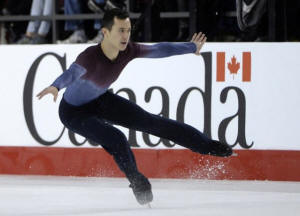|
Chan
fears for skaters' health in era of quads
 Send a link to a friend
Send a link to a friend
 [April 19, 2017]
By Pritha Sarkar [April 19, 2017]
By Pritha Sarkar
(Reuters) - Men's figure skating has
been caught up in an airborne whirl lately - as the number of
quadruple jumps being landed is rapidly mounting with each
competition.
As thrilling as it is to see teenagers Nathan Chen or Shoma Uno cram
in as many aerial revolutions as humanly possible into their
high-risk jumps, Canada's Patrick Chan believes there is a risk of
injury, although he fears the governing body ISU will not take
action until "somebody actually does get hurt".
Earlier this month at the world championships in Helsinki, Chan
landed three quadruple jumps in a free skate for the first time in
his career but even that was not good enough for a medal.
Instead the medals went to Japanese sensations Yuzuru Hanyu (gold)
and Uno (silver) and China's Jin Boyang. For the first time at the
worlds, four quads had been executed by each of the medalists in
their long programs.
"For me skating is a whole different world than it is in Japan. In
Japan skating is like NHL hockey in Canada or baseball in the U.S.
So pushing the limit is very enticing. Skating is their lives," Chan
told Reuters in an interview ahead of this week's World Team Trophy
in Tokyo.
"I have a life outside of skating. I want to extend my career other
than what I do in competition.

"Iím going to stick to what I can do... because if I try and ... do
the impossible, I will either get too frustrated to the point where
I wonít enjoy the sport anymore or I will get hurt and maybe have to
get hip replacements at age 30."
Holding on to his original body parts is non-negotiable for the
26-year-old Chan, who was almost 20 when he mastered his first quad
-- the toeloop.
In an attempt to keep pace with the teen brigade, Chan has been
forced to retrain his body in his mid 20s and has added a quad
Salchow to his arsenal.
But even that has not been enough.
Chan was in awe after watching American Chen win this year's Four
Continents title by landing four different quads, and five in total,
in his free skate.
However, Chan has no aspirations to follow suit even with the
Pyeongchang Winter Olympics looming next February.
MASKING PAIN
"The advantage of a 17-year-old like Nathan and Shoma ... (is that)
there is a bit of disconnect between the toll their bodies are
physically going through and the connection to the brain where itís
sending the pain," said Chan, who won a hat-trick of world titles
from 2011 to 2013.
"Even if thereís an injury, because you are young ... your body is
really efficient at recovering quickly and masking potential
injuries.
"However, we are treading into the unknown when it comes to menís
skating. Maybe they (the ISU) need to limit the amount of quads you
can do in the long program.
"But I donít think that will happen until somebody actually does get
hurt."
Chan rolled his eyes when he heard Olympic champion Hanyu claim
"scientifically... five rotations in the air is a possibility".
[to top of second column] |

Patrick Chan performs during the men's free program in the 2017
Canadian National Figure Skating Championships at TD Place.
Mandatory Credit: Eric Bolte-USA TODAY Sports

To fit in that extra revolution, skaters would need
to jump higher, spin faster and stay airborne longer than the
current average of 0.7 seconds.
And with the tyros determined to push their nimble bodies further --
it is not inconceivable that the next frontiers will soon be
conquered -- be it a quad-Axel (requiring 4-1/2 rotations), a
quad-quad combination or even a quintuple jump.
"When I won worlds (in 2011)... I thought there was no way anyone
would do a quad Lutz in my lifetime, let alone during my career. But
I was proven wrong," said Chan, who hopes to add a quad flip to his
repertoire in time for the Olympics.
"So maybe a quint will happen but jeez, I for sure will not be able
to do that because my body will not be able to handle that."
So is the accumulative points system, which replaced the now-defunct
6.0 scoring method following the 2002 Olympics judging scandal, to
blame for the sport becoming an exhibition in power-jumping?
Skaters can rack up points for executing more and more quads.
During the worlds, Chen attempted a record eight quads over two
programs and earned a whopping 19.47 points for his quadruple
Lutz-triple toeloop combination in his short skate -- the highest
score awarded in Helsinki for a single element.
"The judging system is along for the ride as opposed to leading us
to add more quads. The menís field have taken it and morphed it to
their strengths," Chan said.
However, the rapidly changing landscape in men's figure skating
means that the artistic and aesthetically pleasing performers, such
as Chan and two-times world champion Javier Fernandez, may soon
become an extinct breed.

"Unfortunately... I definitely donít see another Javi or another me
coming up in the world of skating. I see a lot of Boyangs and lot of
Shomas coming up in the sport in the junior level," Chan said.
"Thatís the direction dictated by the judges and how the events are
being judged."
(Reporting by Pritha Sarkar, editing by Toby Davis) [© 2017 Thomson Reuters. All
rights reserved.]
Copyright 2017 Reuters. All rights
reserved. This material may not be published, broadcast, rewritten
or redistributed. |